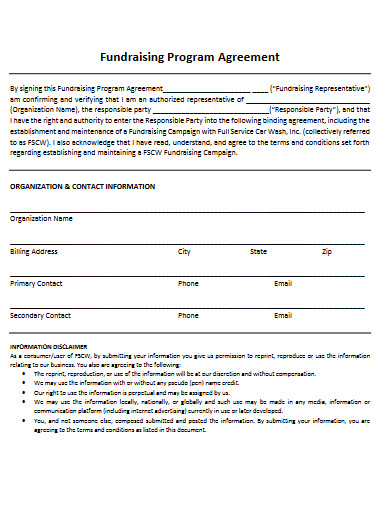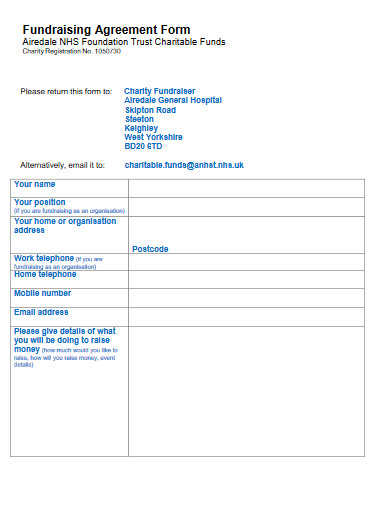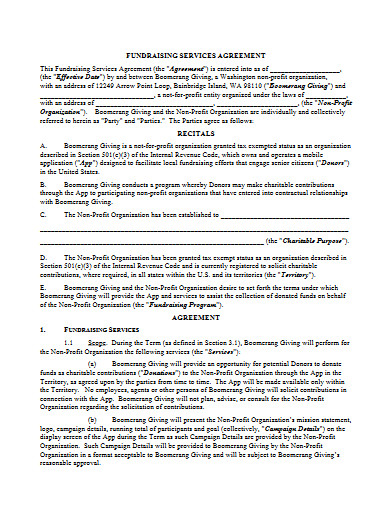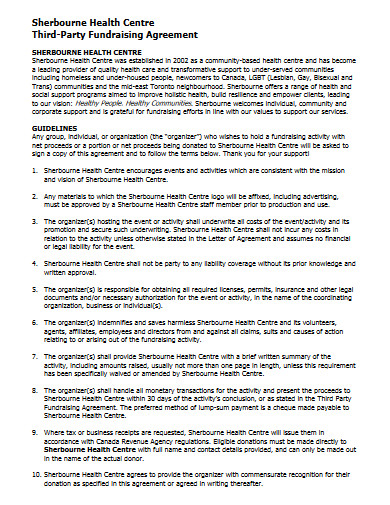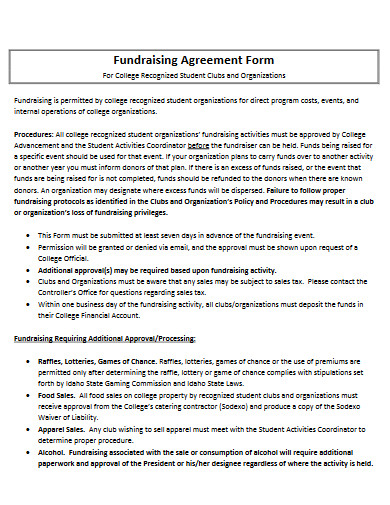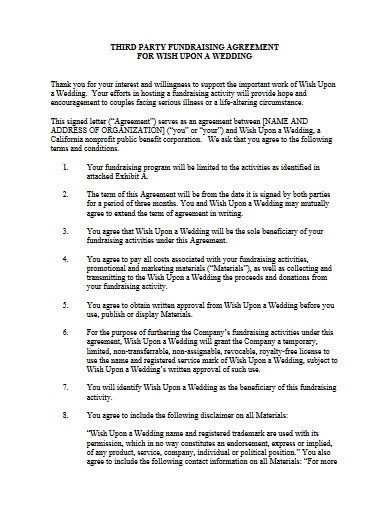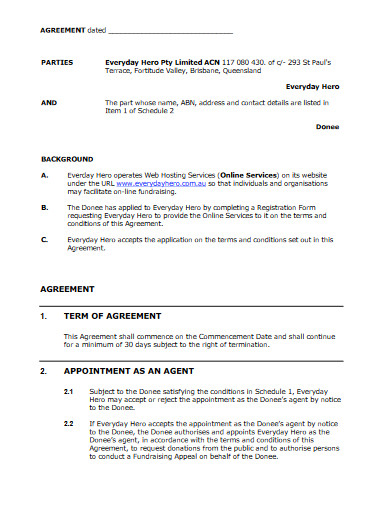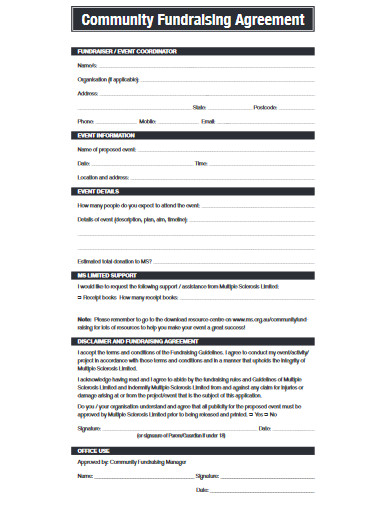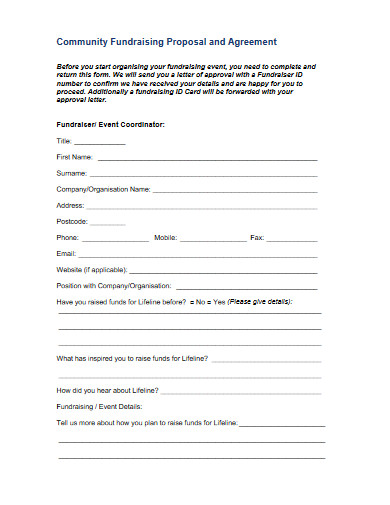10+ Fundraising Agreement Examples to Download
Nonprofit organizations have many options to generate the financial means to provide charity or execute their philanthropic efforts. One of them is by cash donations that they can get from business sponsorships or partnerships and fundraiser events, like sports tournaments, educational campaigns, and others. To get these fundraising goals to happen, the nonprofit organizations have to get into formal and signed settlements with financiers. Most of the time, these two parties have legal representations who handle the paperwork for them. But, there’s always the option to produce the documents on their own. And if you’re planning to make such documents by yourself, then proceed to our article below for your guidance.
10+ Fundraising Agreement Examples
1. Fundraising Agreement Template
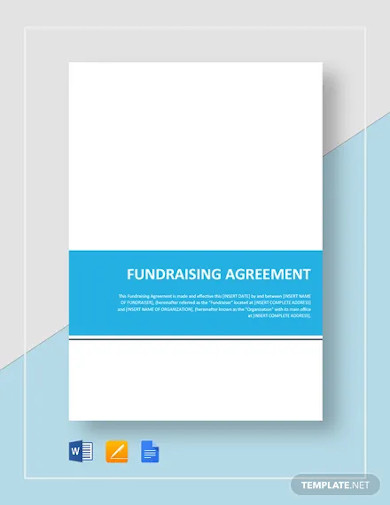
2. Restaurant Fundraising Agreement Template
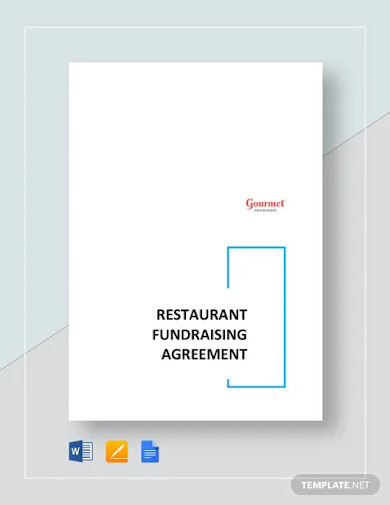
3. Fundraising Program Agreement
4. Trust Fundraising Agreement
6. Heath Center Fundraising Agreement
7. Fundraising Agreement Form
8. Third Party Fundraising Agreement
9. Fundraising Agreement Example
10. Community Fundraising Agreement
11. Community Fundraising Proposal and Agreement
What Is a Fundraising Agreement?
A fundraising agreement is a document that binds a nonprofit organization and a benefactor in fulfilling their funding obligations for a certain event or campaign. It can be a legal document by choice. Inside it are the specifications on the different areas of a business arrangement, including the terms and conditions, fundings, termination, and many more. Some of its many benefits involve the clarification of business relationships, avoidance of disputes, and the prevention of misinterpretations. Moreover, it helps protect any kind of property and accords to any documentation policy. This type of agreement is also applicable to for-profit organizations that have strategic fundraising plans.
Types of Agreement Breach
There are times when one of the parties in an agreement fails to carry off their obligations. Such a situation is known as an agreement breach. There are many types of agreement breach. They include the following:
1. Material Breach – This breach occurs when one party completely failed to produce the amount or quality of products and services according to what has been agreed. Late delivery also falls under this classification.
2. Minor Breach – Also known as an immaterial breach, this type refers to the situations when deliverable are conveyed incompletely.
3. Anticipatory Breach – This type of breach describes the instance when the non-breaching party calls it so before the breach actually happens based on the obvious indications that the other party can’t fulfill their obligations.
4. Actual Breach – Unlike anticipatory, this type of breach refers to the situation when the non-breaching party declares a dispute after the breach occurred.
How To Create a Fundraising Agreement?
A fundraising agreement plays a very crucial role in protecting and guiding the undertaking between an organization and its potential financier. This is why it has to be made thoroughly and accurately. If you want to ensure the completeness and conciseness of your agreement’s content, then you better check out our outline of the steps and insights below!
1. Define the Purpose
In technical writing, specifically about agreements, you need to start with the objective statements. In this section, you have to define the purpose of your planned agreement clearly. Make sure to mention the name of the event or campaign, and provide a brief description of its corresponding short-term goals.
2. Introduce the Participants
Every agreement should have two or more parties. One of the parties will be the one to offer the deal, while the others will be the ones to accept it. The participants in fundraising agreements can be classified into two, the receiving party and the funding party. These titles will be frequently used to recognize the participants all throughout the document after their complete names are mentioned.
3. Cite the Terms and Conditions
Once you’re done introducing the participants, cite or provide the terms and conditions right away. This part of your agreement should include the description of obligations, fundraising methods, and regulatory requirements. According to Donorbox, fundraising has ten methodologies. They consist of direct mail, events, online donations, door-to-door solicitation, phone solicitations, email marketing, text-to-give, crowdfunding, partnerships or sponsorships or grants, and peer-to-peer fundraising. Each of these has its pros and cons.
4. Elaborate the Funding
After setting the terms and conditions, discuss how the funds will be transmitted from the financier to the receiving organization. Aside from that, the important points of the compensation plan for the volunteers and fundraising operation staff has to be presented. Not to mention, the specifications on the indemnification should also be clearly stated.
5. Make a Termination Clause
Not all agreements end up successful. Some of them are terminated for various reasons. One situation is when an agreement’s short-term and long-term goals have been set in an impossible manner. Other causes are fraud, misrepresentation, illegality, and breaches. Because of these reasons, a clause that details the termination policies and procedures has to be made.
6. Seal the Deal
To finalize the agreement between the receiving party and the funding party, both participants’ representatives should imprint their respective signatures. These imprints are required whether or not both want it to become a legal document. They act as proof that the two parties gave their consents to do the obligations of the settlement and suffer the consequence if they failed to do so.
FAQs:
What is a legal representation?
Legal representation is a practice where a lawyer represents a certain client in a court and performs the duties that ensure the legalities of his or her client’s undertakings. This practice is common in making company agreements, legal contracts, flexible workplace policy and procedures, and other legal paperwork.
What is the difference between fundraising and crowdfunding?
Fundraising is when an organization generates its financial means by hosting charities or other philanthropic activities. On the other hand, crowdfunding refers to soliciting funds from large groups or organizations.
What is the difference between an agreement and a contract?
According to Justin McCullough of the JotForm blog site, an agreement is usually an arrangement that is often done informally by two or more parties. In comparison, a contract is made formally with the terms and conditions set to be enforceable by the law.
Fundraising has always been one of the many reasons why most nonprofit organizations survived long enough to continue their charitable activities. But before such organizations can perform any fundraising venture, they need partners and process documents to bind them with their obligations. And so, the fundraising agreement came to existence.



